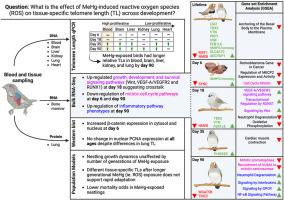慢性亚致死暴露于甲基汞会延长发育中的斑胸草雀的端粒
IF 7.3
2区 环境科学与生态学
Q1 ENVIRONMENTAL SCIENCES
引用次数: 0
摘要
甲基汞(MeHg)是一种广泛存在的环境污染物,已知会导致DNA和染色体损伤,部分是通过活性氧(ROS)引起的。端粒对染色体保护至关重要,对氧化损伤和随之而来的缩短高度敏感。虽然体外ros依赖性氧化应激加速端粒磨损,但体内长期暴露于诱导ros的外源性药物影响端粒长度的机制尚不清楚。我们研究了亚致死、多代甲基汞暴露对斑马雀(Taeniopygia guttata)早期端粒动力学的影响。持续暴露于环境相关浓度的膳食甲基汞(1.2 mg/kg)会导致性成熟时红细胞、脑、肝、肾和肺的相对端粒变长。没有证据表明甲基汞暴露的几代人选择了更长的端粒。肺中增殖细胞核抗原(PCNA)(一种DNA合成标记物)的蛋白表达保持不变,表明端粒维持或伸长独立于增殖发生。然而,Wnt信号的关键转录因子β-Catenin的表达在mehg暴露的雏鸟中增加。骨髓转录组学分析显示,致癌和促炎信号通路上调,有丝分裂细胞周期通路下调。综合起来,我们的数据揭示了肿瘤发生的细胞过程,并提示端粒在慢性应激下的复制不朽。本文章由计算机程序翻译,如有差异,请以英文原文为准。

Chronic Sublethal Exposure to Methylmercury Lengthens Telomeres in Developing Zebra Finches
Methylmercury (MeHg) is a widespread environmental pollutant known to cause DNA and chromosomal damage, in part through reactive oxygen species (ROS). Telomeres, essential for chromosomal protection, are highly sensitive to oxidative damage and consequent shortening. While ROS-dependent oxidative stress accelerates telomere attrition in vitro, the mechanisms by which chronic exposure to ROS-inducing exogenous agents affects telomere length in vivo remain unclear. We studied effects of sublethal, multi-generational MeHg exposure on telomere dynamics during early life in zebra finches (Taeniopygia guttata). Continuous exposure to an environmentally relevant concentration of dietary MeHg (1.2 mg/kg) resulted in longer relative telomeres in red blood cells, brain, liver, kidney and lung by sexual maturity. No evidence of selection for longer telomeres across generations of MeHg exposure was observed. Lung protein expression of proliferating cell nuclear antigen (PCNA), a DNA synthesis marker, remained unchanged, suggesting telomere maintenance or elongation occurs independently of proliferation. However, β-Catenin expression, a key transcription factor in Wnt signaling, increased in young MeHg-exposed birds. Transcriptomic analysis of bone marrow revealed up-regulation of oncogenic and pro-inflammatory signaling pathways and down-regulation of mitotic cell cycle pathways. Combined, our data reveal cellular processes reminiscent of tumorigenesis and suggestive of replicative immortality of telomeres under chronic stress.
求助全文
通过发布文献求助,成功后即可免费获取论文全文。
去求助
来源期刊

Environmental Pollution
环境科学-环境科学
CiteScore
16.00
自引率
6.70%
发文量
2082
审稿时长
2.9 months
期刊介绍:
Environmental Pollution is an international peer-reviewed journal that publishes high-quality research papers and review articles covering all aspects of environmental pollution and its impacts on ecosystems and human health.
Subject areas include, but are not limited to:
• Sources and occurrences of pollutants that are clearly defined and measured in environmental compartments, food and food-related items, and human bodies;
• Interlinks between contaminant exposure and biological, ecological, and human health effects, including those of climate change;
• Contaminants of emerging concerns (including but not limited to antibiotic resistant microorganisms or genes, microplastics/nanoplastics, electronic wastes, light, and noise) and/or their biological, ecological, or human health effects;
• Laboratory and field studies on the remediation/mitigation of environmental pollution via new techniques and with clear links to biological, ecological, or human health effects;
• Modeling of pollution processes, patterns, or trends that is of clear environmental and/or human health interest;
• New techniques that measure and examine environmental occurrences, transport, behavior, and effects of pollutants within the environment or the laboratory, provided that they can be clearly used to address problems within regional or global environmental compartments.
 求助内容:
求助内容: 应助结果提醒方式:
应助结果提醒方式:


